Input interpretation

aluminum oxide | element types
Result

aluminum | oxygen
Periodic table location
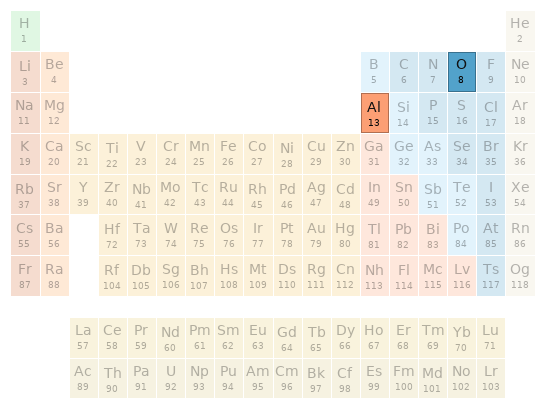
Periodic table location
Images
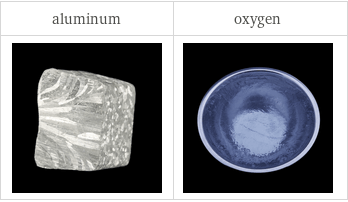
Images
Basic elemental properties
![| aluminum | oxygen atomic symbol | Al | O atomic number | 13 | 8 short electronic configuration | [Ne]3s^23p^1 | [He]2s^22p^4 Aufbau diagram | 3p 3s | 2p 2s block | p | p group | 13 | 16 period | 3 | 2 atomic mass | 26.9815385 u | 15.999 u half-life | (stable) | (stable)](../image_source/e928ebb145f0eb282756e451d394e21f.png)
| aluminum | oxygen atomic symbol | Al | O atomic number | 13 | 8 short electronic configuration | [Ne]3s^23p^1 | [He]2s^22p^4 Aufbau diagram | 3p 3s | 2p 2s block | p | p group | 13 | 16 period | 3 | 2 atomic mass | 26.9815385 u | 15.999 u half-life | (stable) | (stable)
Thermodynamic properties

| aluminum | oxygen phase at STP | solid | gas melting point | 660.32 °C | -218.3 °C boiling point | 2519 °C | -182.9 °C critical temperature | | 154.59 K critical pressure | | 5.043 MPa molar heat of fusion | 10.7 kJ/mol | 0.222 kJ/mol molar heat of vaporization | 293 kJ/mol | 3.41 kJ/mol specific heat at STP | 904 J/(kg K) | 919 J/(kg K) adiabatic index | | 7/5 (properties at standard conditions)
Material properties
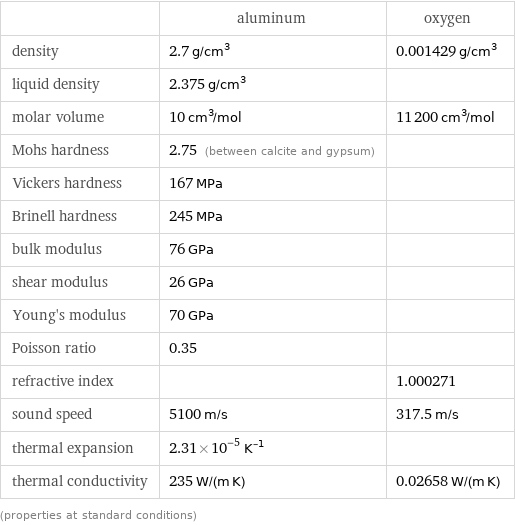
| aluminum | oxygen density | 2.7 g/cm^3 | 0.001429 g/cm^3 liquid density | 2.375 g/cm^3 | molar volume | 10 cm^3/mol | 11200 cm^3/mol Mohs hardness | 2.75 (between calcite and gypsum) | Vickers hardness | 167 MPa | Brinell hardness | 245 MPa | bulk modulus | 76 GPa | shear modulus | 26 GPa | Young's modulus | 70 GPa | Poisson ratio | 0.35 | refractive index | | 1.000271 sound speed | 5100 m/s | 317.5 m/s thermal expansion | 2.31×10^-5 K^(-1) | thermal conductivity | 235 W/(m K) | 0.02658 W/(m K) (properties at standard conditions)
Electromagnetic properties
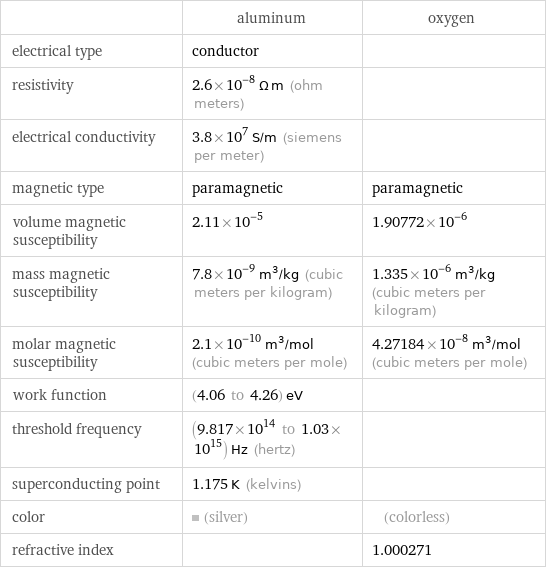
| aluminum | oxygen electrical type | conductor | resistivity | 2.6×10^-8 Ω m (ohm meters) | electrical conductivity | 3.8×10^7 S/m (siemens per meter) | magnetic type | paramagnetic | paramagnetic volume magnetic susceptibility | 2.11×10^-5 | 1.90772×10^-6 mass magnetic susceptibility | 7.8×10^-9 m^3/kg (cubic meters per kilogram) | 1.335×10^-6 m^3/kg (cubic meters per kilogram) molar magnetic susceptibility | 2.1×10^-10 m^3/mol (cubic meters per mole) | 4.27184×10^-8 m^3/mol (cubic meters per mole) work function | (4.06 to 4.26) eV | threshold frequency | (9.817×10^14 to 1.03×10^15) Hz (hertz) | superconducting point | 1.175 K (kelvins) | color | (silver) | (colorless) refractive index | | 1.000271
Reactivity
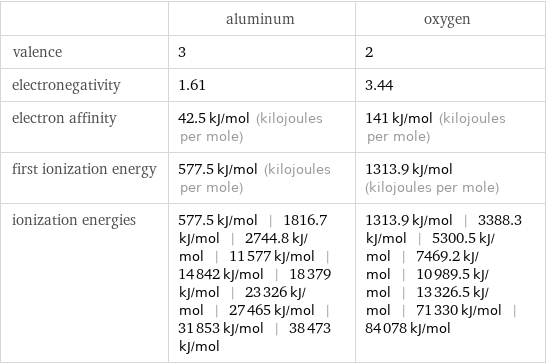
| aluminum | oxygen valence | 3 | 2 electronegativity | 1.61 | 3.44 electron affinity | 42.5 kJ/mol (kilojoules per mole) | 141 kJ/mol (kilojoules per mole) first ionization energy | 577.5 kJ/mol (kilojoules per mole) | 1313.9 kJ/mol (kilojoules per mole) ionization energies | 577.5 kJ/mol | 1816.7 kJ/mol | 2744.8 kJ/mol | 11577 kJ/mol | 14842 kJ/mol | 18379 kJ/mol | 23326 kJ/mol | 27465 kJ/mol | 31853 kJ/mol | 38473 kJ/mol | 1313.9 kJ/mol | 3388.3 kJ/mol | 5300.5 kJ/mol | 7469.2 kJ/mol | 10989.5 kJ/mol | 13326.5 kJ/mol | 71330 kJ/mol | 84078 kJ/mol

Reactivity
Atomic properties
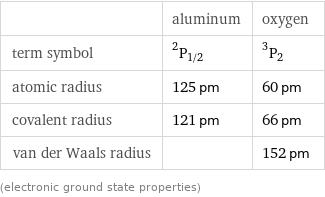
| aluminum | oxygen term symbol | ^2P_(1/2) | ^3P_2 atomic radius | 125 pm | 60 pm covalent radius | 121 pm | 66 pm van der Waals radius | | 152 pm (electronic ground state properties)
Abundances

| aluminum | oxygen universe abundance | 0.005 mass% | 1 mass% solar abundance | 0.006 mass% | 0.9 mass% meteorite abundance | 0.91 mass% | 40 mass% crust abundance | 8.1 mass% | 46 mass% ocean abundance | 5×10^-7 mass% | 86 mass% human abundance | 9×10^-5 mass% | 61 mass% universe molar abundance | 2×10^-4 mol% | 0.08 mol% solar molar abundance | 3×10^-4 mol% | 0.07 mol% meteorite molar abundance | 0.67 mol% | 48 mol% ocean molar abundance | 1.1×10^-7 mol% | 33 mol% crust molar abundance | 6.3 mol% | 60 mol% human molar abundance | 2.1×10^-5 mol% | 24 mol%